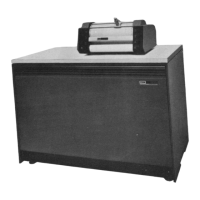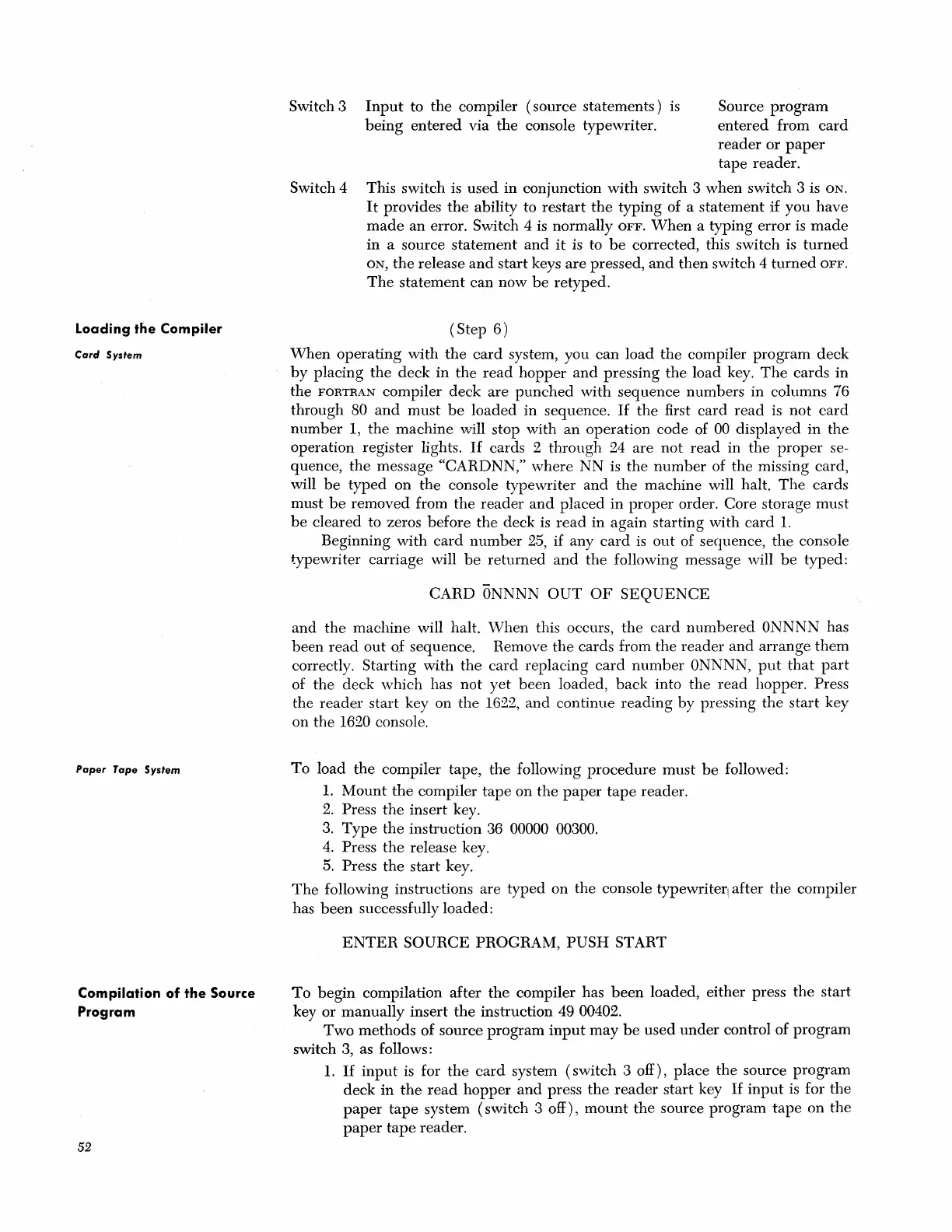Switch 3
Input
to
the
compiler
(source
statements)
is
being
entered
via
the
console typewriter.
Source
program
entered
from
card
reader
or
paper
tape
reader.
Switch 4 This switch is
used
in
conjunction
with
switch 3
when
switch 3 is
ON.
It
provides
the
ability to
restart
the
typing of a
statement
if
you
have
made
an
error. Switch 4 is normally
OFF.
When
a
typing
error is
made
in
a source
statement
and
it
is to
be
corrected, this switch is
turned
ON,
the
release
and
start
keys
are
pressed,
and
then
switch 4
turned
OFF.
The
statement
can
now
be
retyped.
Loading the Compiler
(Step
6)
Card
System
Paper
Tape
System
Compilation
of
the Source
Program
52
When
operating
with
the
card
system, you
can
load
the
compiler
program
deck
by
placing
the
deck
in
the
read
hopper
and
pressing
the
load
key.
The
cards in
the
FORTRAN
compiler
deck
are
punched
with
sequence
numbers in columns 76
through
80
and
must
be
loaded
in sequence.
If
the
first
card
read
is
not
card
number
1,
the
machine
will stop
with
an
operation code of 00 displayed
in
the
operation register lights.
If
cards 2
through
24 are
not
read
in
the
proper
se-
quence,
the
message
"CARDNN,"
where
NN
is
the
number
of
the
missing card,
will
be
typed
on
the
console
typewriter
and
the
machine
will halt.
The
cards
must
be
removed
from
the
reader
and
placed
in
proper
order.
Core
storage
must
be
cleared to zeros
before
the
deck is
read
in again starting
with
card
1.
Beginning
with
card
number
25,
if
any
card
is
out
of sequence,
the
console
typewriter carriage will
be
returned
and
the
following message will
be
typed:
CARD
ONNNN
OUT
OF
SEQUENCE
and
the
machine
will halt.
When
this occurs,
the
card
numbered
ONNNN has
been
read
out
oJ sequence. Remove
the
cards from
the
reader
and
arrange
them
correctly. Starting
with
the
card
replacing
card
number
ONNNN,
put
that
part
of
the
deck
which
has
not
yet
been
loaded,
back
into
the
read
hopper. Press
the
reader
start
key on
the
1622,
and
continue
reading
by
pressing
the
start
key
on
the
1620 console.
To
load
the
compiler tape,
the
following
procedure
must
be
followed:
1.
Mount
the
compiler
tape
on
the
paper
tape
reader.
2.
Press
the
insert key.
3.
Type
the
instruction 36 00000 00300.
4.
Press
the
release key.
5.
Press
the
start
key.
The
following instructions are
typed
on
the
console typewriter! after
the
compiler
has
been
successfully loaded:
ENTER
SOURCE
PROGRAM,
PUSH
START
To
begin
compilation
after
the
compiler has
been
loaded, either press
the
start
key
or
manually
insert
the
instruction 49 00402.
Two
methods
of source
program
input
may
be
used
under
control of
program
switch 3, as follows:
1.
If
input
is for
the
card
system
(switch
3 off), place
the
source
program
deck
in
the
read
hopper
and
press
the
reader
start
key
If
input
is for
the
paper
tape
system
(switch
3 off),
mount
the
source
program
tape
on
the
paper
tape
reader.

